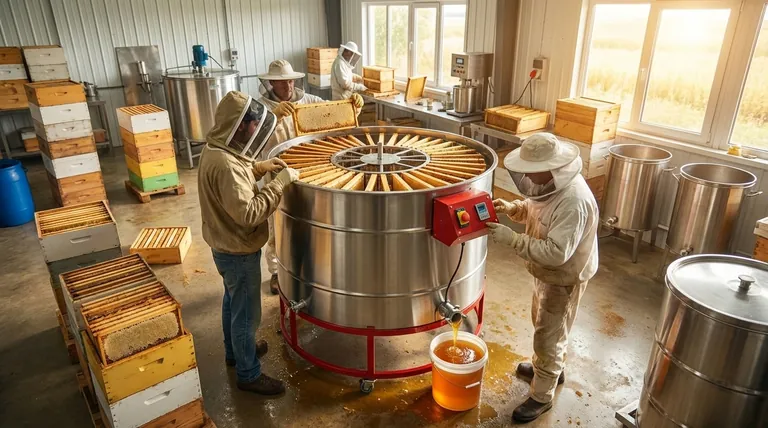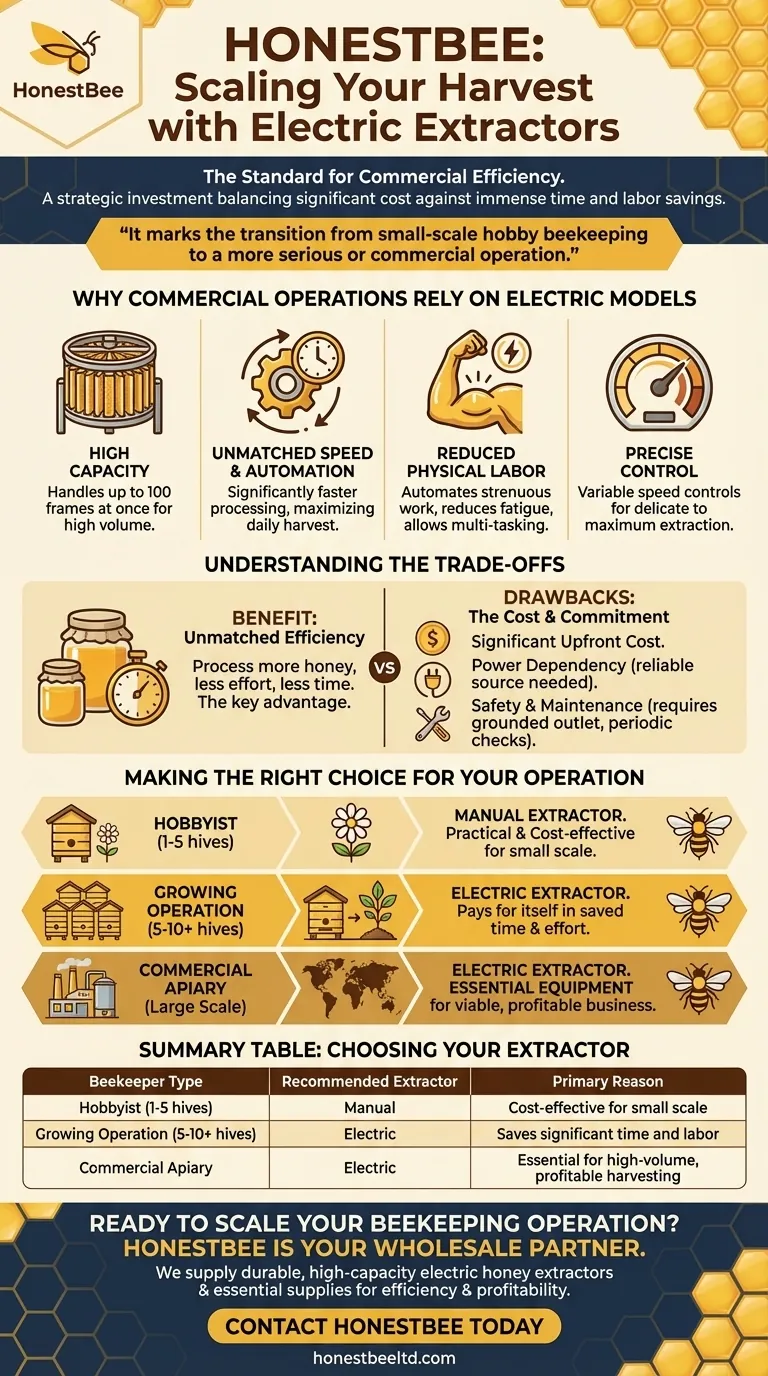In short, electric honey extractors are the standard equipment for large-scale commercial beekeepers. Their primary value lies in their speed and efficiency, which are critical for processing the high volume of honey produced by dozens or hundreds of hives.
The decision to use an electric honey extractor is a strategic one, balancing the significant upfront cost against the immense savings in time and physical labor. It marks the transition from small-scale hobby beekeeping to a more serious or commercial operation.

Why Commercial Operations Rely on Electric Models
An electric extractor is an investment in operational efficiency. For beekeepers whose livelihood depends on honey production, this efficiency is non-negotiable.
The Need for High Capacity
Commercial apiaries manage a large number of frames during harvest. Electric extractors are built to handle this volume, with some models capable of holding up to 100 frames at once.
Unmatched Speed and Automation
The extraction process is significantly faster with an electric motor. This allows beekeepers to process more honey in a single day, a crucial factor during the short and intense harvest season.
Reduced Physical Labor
Manually cranking a honey extractor for hours is physically demanding. An electric model automates the most strenuous part of the job, reducing fatigue and allowing the beekeeper to focus on other tasks, like uncapping the next batch of frames.
Precise Control Over the Process
Many electric extractors come with variable speed controls. This allows the operator to start the spin slowly to avoid damaging delicate new comb and then increase the speed for maximum extraction, offering a level of control that is difficult to achieve manually.
Understanding the Trade-offs
While powerful, an electric extractor is not the right choice for every beekeeper. The benefits must be weighed against clear and practical downsides.
The Benefit: Unmatched Efficiency
The core advantage is the ability to process more honey with less effort in less time. This is the single biggest reason professionals choose them.
The Drawback: Significant Cost
Electric extractors are considerably more expensive than their manual counterparts. This upfront investment is often the largest barrier for hobbyists or small-scale beekeepers.
The Drawback: Power Dependency
An electric extractor requires a reliable power source. This can be a challenge in remote bee yards or off-grid locations, where a manual extractor might be the only practical option.
The Drawback: Safety and Maintenance
As with any powered equipment, safety is a key consideration. The machine must be stable, and operators must be cautious of moving parts. Electrical components require periodic checks, and using a properly grounded outlet is essential to prevent electrical hazards.
Making the Right Choice for Your Operation
To decide if an electric extractor is right for you, evaluate the scale of your operation and your long-term goals.
- If your primary focus is a small hobby (1-5 hives): A manual extractor is almost always more practical and cost-effective for your needs.
- If your primary focus is a growing operation (5-10+ hives) or you have physical limitations: The investment in an electric model will quickly pay for itself in saved time and effort.
- If your primary focus is commercial production: An electric extractor is not a luxury; it is essential equipment for a viable and profitable business.
Ultimately, choosing the right extractor is about aligning your equipment with the scale and ambition of your beekeeping journey.
Summary Table:
| Beekeeper Type | Recommended Extractor | Primary Reason |
|---|---|---|
| Hobbyist (1-5 hives) | Manual | Cost-effective for small scale |
| Growing Operation (5-10+ hives) | Electric | Saves significant time and labor |
| Commercial Apiary | Electric | Essential for high-volume, profitable harvesting |
Ready to Scale Your Beekeeping Operation?
If you manage a commercial apiary or are a beekeeping equipment distributor, HONESTBEE is your trusted wholesale partner. We supply durable, high-capacity electric honey extractors and other essential beekeeping supplies designed for efficiency and profitability.
Contact HONESTBEE today to discuss your wholesale needs and discover how our equipment can maximize your honey yield and streamline your harvest process.
Visual Guide

Related Products
- HONESTBEE 72 Frame Industrial Electric Honey Extractor for Beekeeping
- 8-Frame Electric Self-Reversing Honey Extractor Spinner for Commercial Honey Extraction Equipment
- Electric 8 Frame Honey Spinner Extractor Equipment for Beekeeping
- 6 Frame Manual Stainless Steel Honey Extractor Beekeeping Equipment
- Honey Concentrating Vacuum Heating Thickening Machine Dehumidifier for Honey
People Also Ask
- What should a beekeeper do after extracting honey from supers? A Guide to Harvest Management
- What are the advantages of automated honey extractors in terms of time efficiency? Boost Your Harvest Speed
- Why is preserving honeycomb integrity important, and how do automated extractors help? Boost Hive Health & Honey Yields
- What is the energy consumption like for automatic honey extractors? Maximize Your Harvest Efficiency
- Why do beekeepers have to lift a lot of weight at the end of a growing season? The Reward of a Heavy Harvest



















